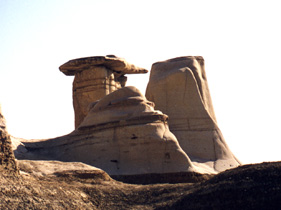writers and hoodoos

Hoodoos near Drumheller – photo by Marja-Leena
A few days ago I found Anita Konkka’s fascinating writer’s dairy. I quickly became absorbed reading the beautifully written entries, in a Finnish that I was able to understand and enjoy easily. (I’ve sometimes been frustrated not understanding today’s slang used by many Finnish bloggers.)
Anita Konkka is the author of many novels, essays, radio-plays, and a dream-book. Some of her novels address the question of Ingrian identity because of her father’s roots (the Ingrian Finns are from around St. Petersburg). Other novels are richly informed by dream studies and diverse cultural mythologies. An English translation of “In the Fool’s Paradise” is forthcoming (Dalkey Archive Press, 2006) which I will definitely look for in the North American market. I must try to get some of her Finnish books in the meantime! English readers will enjoy Anita’s excerpts of her writings at her literary website.
Attracted by her interest in dreams, myths and culture, including that of Russia, I emailed her and was very pleasantly surprised to receive a nice reply. Anita expressed fascination for the hoodoos in my “Silent Messengers” prints and had several good questions, which I think might interest my regular readers too.
What are hoodoos? These are geological formations of weathered rock in columnar or pillar forms and sometimes with caps. The Writing-on-Stone Provincial Park website has a good explanation as does Wikipedia.
Do the hoodoos have native petroglyphs or pictographs? “For hundred of years, the Blackfoot people visited this valley and believed that this amazing place was sacred and the home of spirits. Although it is rare for rock art to be found on hoodoos, there are both pictographs and petroglyphs upon the sandstone cliffs along the Milk River” in Writing on Stone Provincial Park. This is why I am still planning to visit these sites.
Is “hoodoo” an aboriginal word? This question stumped me as I’d not seen anything about its etymology. Googling found another writer, this time Canadian Bill Casselman, a broadcaster and the author of many books on Canadian words, sayings and names. He wrote an interesting story behind the word “hoodoo” and how it has nothing to do with “voodoo” as others have claimed. Here’s an excerpt:
“American aboriginal peoples of the northwest picked up the word hoodoo from English-speaking fur trappers and, like them, used hoodoo to refer to any malignant creature or evil supernatural force. That’s how it came to be applied to the curious columns of earth or rock. For they were thought to be evil in the mythologies of many first peoples. But, borrowing works in the other direction as well. For example, in Siksika (Blackfoot) mythology, the strange hoodooesque shapes were giants whom the Great Spirit had turned to stone because of their evil deeds. Deep in the night, the petrified giants could awaken and throw boulders down upon any humans passing nearby.”
No wonder hoodoos are such an attraction to artists and writers! Thanks to new virtual friend, Anita, for the great questions!
July 8, 2005 in Being an Artist, Folk Legends & Myths, Photoworks, Rock Art & Archaeology, Rocks by Marja-Leena